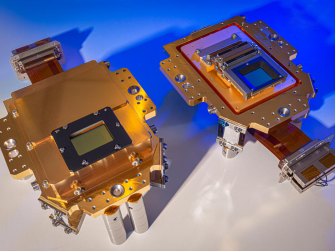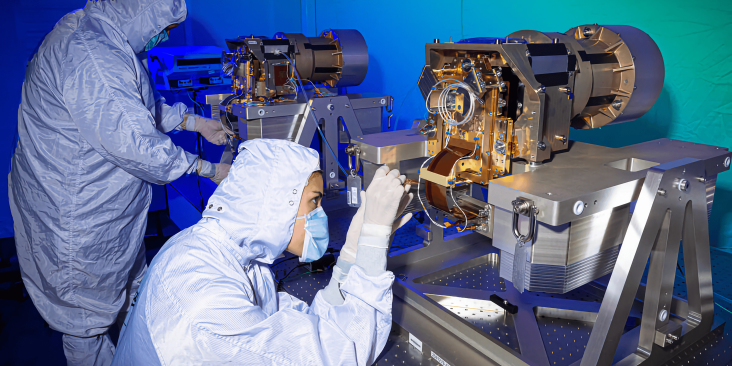On June 20, 2025, MethaneSAT mission operations lost contact with MethaneSAT. After pursuing all options to restore communications, we now believe it’s unlikely the satellite can be recovered.
While this is difficult news, it’s not the end of the overall MethaneSAT effort, or of our work to slash methane emissions. The pioneering science, technology and advocacy of this mission will continue.
Slashing methane emissions as quickly as possible is the fastest way to slow global warming. EDF helped reveal the full magnitude of the problem over a decade ago and we’ve been fighting for urgent solutions ever since.
The missing link is the data on methane emissions
Some companies and governments have started to act, but progress has been slow. Once we have a fuller picture of the problem, we can target emissions where we need them most.
MethaneSAT can tell us where methane is coming from, how much is being emitted and how those emissions change over time. This will give us the best understanding yet of global methane emissions and whether we’re making progress in reducing them.
The problem isn’t just big emitters, but also the millions of smaller sources over vast regions around the world. Today’s satellites aren’t looking for these smaller sources, which is why we created MethaneSAT — and launched it this year.
Because its technology combines wide mapping of emissions with precision spotting, MethaneSAT will capture the world’s first complete picture of methane pollution.
Advanced automation techniques will slash the amount of time it takes to gather useful data — so companies and governments can take action sooner.
MethaneSAT’s data will enable climate scientists, advocacy groups, media and the public to hold governments, policymakers and industries accountable, leaving little doubt whether those who are making commitments to reduce emissions are actually meeting them.
See how MethaneSAT is different than other methane-tracking satellites
Opportunity grows to cut planet-warming methane
Ever since EDF’s groundbreaking work showing that methane emissions were a much bigger problem than the United States government thought, methane has become a central focus during international climate negotiations.
As a result, many countries are creating powerful new laws and regulations:
- One hundred fifty countries have signed a Global Methane Pledge, launched by the U.S. and European Union at the 2021 United Nations climate talks.
- In the U.S., the Biden administration has developed regulations requiring oil and gas companies to monitor and reduce methane emissions from their operations.
- In 2022, the U.S. Congress placed a fee on excess methane emissions from oil and gas production and processing, which will start in 2025.
- In 2023, the European Union agreed on the bloc’s first plan to regulate methane emissions from oil and gas, including from imported natural gas.
So MethaneSAT data will arrive at a critical moment. It will show where companies and governments can target emission reductions immediately to comply with the new regulations and commitments they have made.

Who will use MethaneSAT data, and how?
We’re making sure industry, governments, investors and other stakeholders are ready and able to use MethaneSAT data to track both voluntary and mandatory methane reductions.
Now that more than 50 oil companies have pledged to reduce their total methane emissions to just 0.2% by 2030 — which could mean reductions of up to 90% from each company — MethaneSAT will help track their progress.
EDF, the International Energy Agency and the U.N.’s Environment Organization will provide data that is crucial for the companies actively trying to reduce leaks.
Governments, commercial gas buyers and nonprofit groups will also use the data to build solutions and craft policies that will hold polluters accountable.
MethaneSAT will allow EDF and our partners to determine if companies are actually reducing their methane emissions over time, while also helping us better understand if these targets are ambitious enough.
See how our MethaneAIR jet project paved the way for MethaneSAT
How MethaneSAT data will support stronger regulations
MethaneSAT data will also provide critical support to governments as they require oil and gas companies to reduce emissions. For example:
- As the European Union moves forward to limit methane emissions on gas it imports, MethaneSAT can help verify which companies that produce natural gas are exceeding those limits.
- While the U.S. Environmental Protection Agency implements its new methane rule to reduce emissions from leaks, flares and super-emitters, data from platforms like MethaneSAT can help monitor progress.
Initially, our focus will be on the oil and natural gas sector, where we believe the fastest and most cost-effective opportunities lie to reduce emissions.
We’ve partnered with Google to make MethaneSAT and MethaneAIR data available on Google Earth Engine, so it will be accessible around the world.
And because MethaneSAT data will be publicly available, there will be nowhere for polluters to hide.











